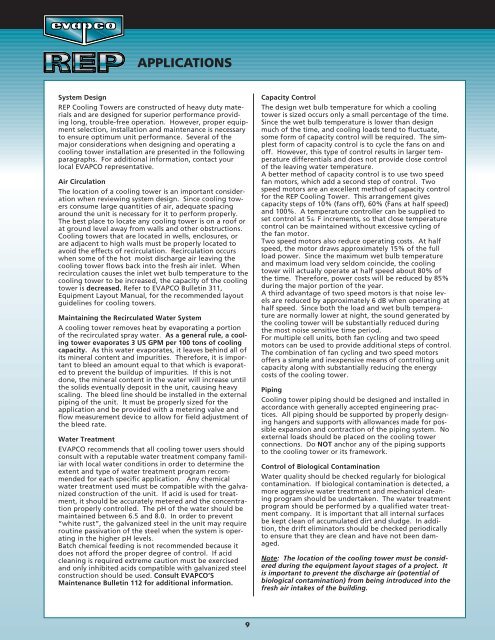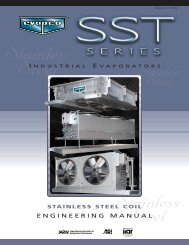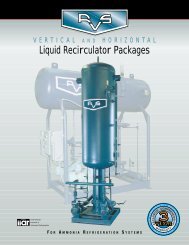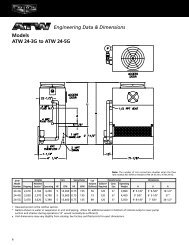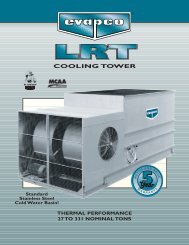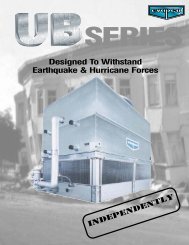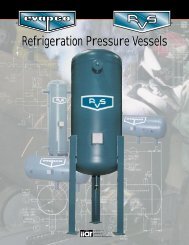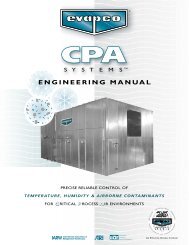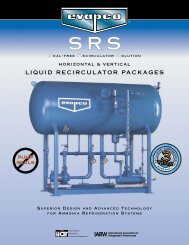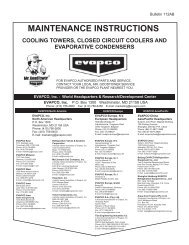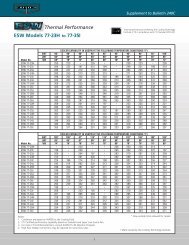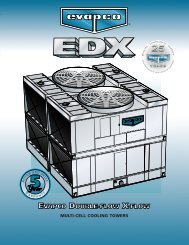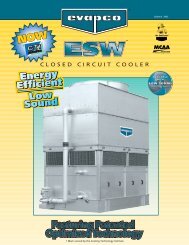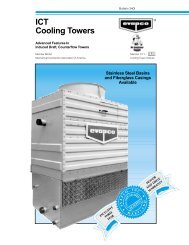You also want an ePaper? Increase the reach of your titles
YUMPU automatically turns print PDFs into web optimized ePapers that Google loves.
APPLICATIONS<br />
System Design<br />
<strong>REP</strong> Cooling Towers are constructed of heavy duty materials<br />
and are designed for superior performance providing<br />
long, trouble-free operation. However, proper equipment<br />
selection, installation and maintenance is necessary<br />
to ensure optimum unit performance. Several of the<br />
major considerations when designing and operating a<br />
cooling tower installation are presented in the following<br />
paragraphs. For additional information, contact your<br />
local EVAPCO representative.<br />
Air Circulation<br />
The location of a cooling tower is an important consideration<br />
when reviewing system design. Since cooling towers<br />
consume large quantities of air, adequate spacing<br />
around the unit is necessary for it to perform properly.<br />
The best place to locate any cooling tower is on a roof or<br />
at ground level away from walls and other obstructions.<br />
Cooling towers that are located in wells, enclosures, or<br />
are adjacent to high walls must be properly located to<br />
avoid the effects of recirculation. Recirculation occurs<br />
when some of the hot moist discharge air leaving the<br />
cooling tower flows back into the fresh air inlet. When<br />
recirculation causes the inlet wet bulb temperature to the<br />
cooling tower to be increased, the capacity of the cooling<br />
tower is decreased. Refer to EVAPCO Bulletin 311,<br />
Equipment Layout Manual, for the recommended layout<br />
guidelines for cooling towers.<br />
Maintaining the Recirculated Water System<br />
A cooling tower removes heat by evaporating a portion<br />
of the recirculated spray water. As a general rule, a cooling<br />
tower evaporates 3 US GPM per 100 tons of cooling<br />
capacity. As this water evaporates, it leaves behind all of<br />
its mineral content and impurities. Therefore, it is important<br />
to bleed an amount equal to that which is evaporated<br />
to prevent the buildup of impurities. If this is not<br />
done, the mineral content in the water will increase until<br />
the solids eventually deposit in the unit, causing heavy<br />
scaling. The bleed line should be installed in the external<br />
piping of the unit. It must be properly sized for the<br />
application and be provided with a metering valve and<br />
flow measurement device to allow for field adjustment of<br />
the bleed rate.<br />
Water Treatment<br />
EVAPCO recommends that all cooling tower users should<br />
consult with a reputable water treatment company familiar<br />
with local water conditions in order to determine the<br />
extent and type of water treatment program recommended<br />
for each specific application. Any chemical<br />
water treatment used must be compatible with the galvanized<br />
construction of the unit. If acid is used for treatment,<br />
it should be accurately metered and the concentration<br />
properly controlled. The pH of the water should be<br />
maintained between 6.5 and 8.0. In order to prevent<br />
“white rust”, the galvanized steel in the unit may require<br />
routine passivation of the steel when the system is operating<br />
in the higher pH levels.<br />
Batch chemical feeding is not recommended because it<br />
does not afford the proper degree of control. If acid<br />
cleaning is required extreme caution must be exercised<br />
and only inhibited acids compatible with galvanized steel<br />
construction should be used. Consult EVAPCO’S<br />
Maintenance Bulletin 112 for additional information.<br />
Capacity Control<br />
The design wet bulb temperature for which a cooling<br />
tower is sized occurs only a small percentage of the time.<br />
Since the wet bulb temperature is lower than design<br />
much of the time, and cooling loads tend to fluctuate,<br />
some form of capacity control will be required. The simplest<br />
form of capacity control is to cycle the fans on and<br />
off. However, this type of control results in larger temperature<br />
differentials and does not provide close control<br />
of the leaving water temperature.<br />
A better method of capacity control is to use two speed<br />
fan motors, which add a second step of control. Two<br />
speed motors are an excellent method of capacity control<br />
for the <strong>REP</strong> Cooling Tower. This arrangement gives<br />
capacity steps of 10% (fans off), 60% (Fans at half speed)<br />
and 100%. A temperature controller can be supplied to<br />
set control at 5& F increments, so that close temperature<br />
control can be maintained without excessive cycling of<br />
the fan motor.<br />
Two speed motors also reduce operating costs. At half<br />
speed, the motor draws approximately 15% of the full<br />
load power. Since the maximum wet bulb temperature<br />
and maximum load very seldom coincide, the cooling<br />
tower will actually operate at half speed about 80% of<br />
the time. Therefore, power costs will be reduced by 85%<br />
during the major portion of the year.<br />
A third advantage of two speed motors is that noise levels<br />
are reduced by approximately 6 dB when operating at<br />
half speed. Since both the load and wet bulb temperature<br />
are normally lower at night, the sound generated by<br />
the cooling tower will be substantially reduced during<br />
the most noise sensitive time period.<br />
For multiple cell units, both fan cycling and two speed<br />
motors can be used to provide additional steps of control.<br />
The combination of fan cycling and two speed motors<br />
offers a simple and inexpensive means of controlling unit<br />
capacity along with substantially reducing the energy<br />
costs of the cooling tower.<br />
Piping<br />
Cooling tower piping should be designed and installed in<br />
accordance with generally accepted engineering practices.<br />
All piping should be supported by properly designing<br />
hangers and supports with allowances made for possible<br />
expansion and contraction of the piping system. No<br />
external loads should be placed on the cooling tower<br />
connections. Do NOT anchor any of the piping supports<br />
to the cooling tower or its framework.<br />
Control of Biological Contamination<br />
Water quality should be checked regularly for biological<br />
contamination. If biological contamination is detected, a<br />
more aggressive water treatment and mechanical cleaning<br />
program should be undertaken. The water treatment<br />
program should be performed by a qualified water treatment<br />
company. It is important that all internal surfaces<br />
be kept clean of accumulated dirt and sludge. In addition,<br />
the drift eliminators should be checked periodically<br />
to ensure that they are clean and have not been damaged.<br />
Note: The location of the cooling tower must be considered<br />
during the equipment layout stages of a project. It<br />
is important to prevent the discharge air (potential of<br />
biological contamination) from being introduced into the<br />
fresh air intakes of the building.<br />
9


